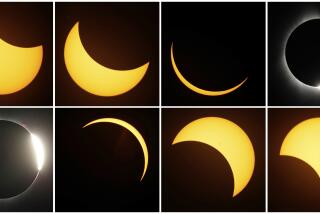Solar filament snakes across the sun, may soon end in violent burst
A giant filament has appeared on the surface of the sun — and NASA’s Solar Dynamics Observatory has captured images of the long, dark formation.
Straightened out, the serpentine filament would measure about 1 million miles from end to end, stretching close to halfway around the sun.
Filaments are enormous clouds of plasma suspended above the surface by magnetic field lines. (Though they look dark, it’s just because they’re backlit by the sun; they’re actually the same thing as the bright solar prominences that arch out from the sun’s edge.)
These features don’t last forever — and when they go, they end in a violent eruption of solar particles.
“That’s one of the coolest things about a filament — when it finally lifts off and you’ll see these million-mile things just rip off the surface of the sun,” said astrophysicist Dean Pesnell, project scientist for the Solar Dynamics Observatory.
These eruptions are called coronal mass ejections. If they’re strong enough and speeding straight toward Earth, they cause geomagnetic storms that can damage satellites in orbit. In rarer instances, they can even cause power outages on the ground.
A coronal mass ejection is different from a solar flare, the bright flash when a bit of magnetic field is converted to radiation, including light and heat. (The Solar Dynamics Observatory has released a video of an M-class flare captured in action Thursday.)
Coronal mass ejections do occur by themselves, but many are linked to flares. As a flare flashes and a bit of magnetic field comes undone, this can trigger a nearby filament (or prominence) to erupt as a CME.
Sometimes those flares don’t even need to be nearby, Pesnell said.
“A flare will happen on one side of the sun, and a wave will propagate from that flare and hit a prominence on another end of the sun, and disrupt it so much that the filament will erupt,” Pesnell said. “Those are the cool ones.”
The sun’s dynamics are so complex that exactly when and why these filaments erupt so dramatically from the surface remains something of a mystery.
“We’d love to understand that — and we’re getting better at it,” Pesnell said. “[We’ve gone] from 16 theories to about nine. So we’re making progress.”
Such filaments can hover above the sun’s surface for weeks, Pesnell said. That’s especially true now, given that the sun is starting to wind down from the solar maximum in its 11-year cycle.
“The sun is going to go bland again,” Pesnell said.
A quieter sun means those filaments can persist for longer, undisturbed.
“Until that magnetic field is destabilized, they’ll just hang out,” Pesnell said.
This filament has been around for about a month, Pesnell said, and it’s unlikely it will reach the two-month mark. When it does finally go, it’ll provide the researchers with a stunning coronal mass ejection.
“It’ll be a nice CME,” Pesnell said. “It’ll start at one end, and the whole thing will just lift off.”
Want more fun on the sun? Follow @aminawrite for more fascinating science news.






